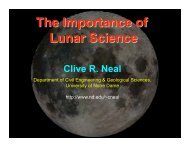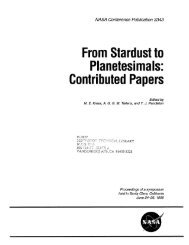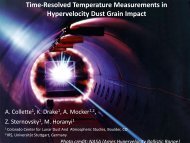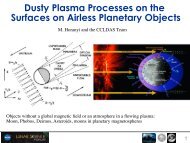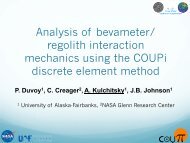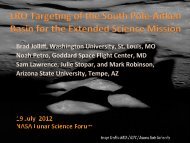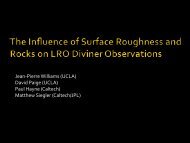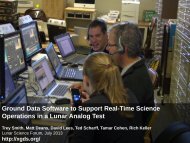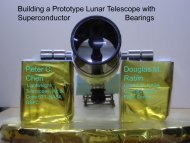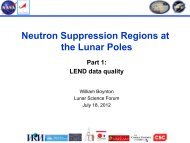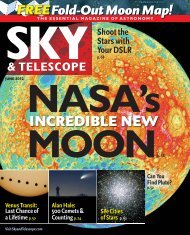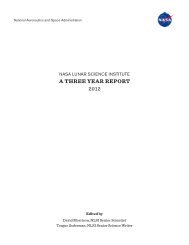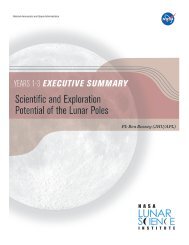Astrophysics and Heliophysics from the Moon - NASA Lunar ...
Astrophysics and Heliophysics from the Moon - NASA Lunar ...
Astrophysics and Heliophysics from the Moon - NASA Lunar ...
You also want an ePaper? Increase the reach of your titles
YUMPU automatically turns print PDFs into web optimized ePapers that Google loves.
<strong>Astrophysics</strong> <strong>and</strong> <strong>Heliophysics</strong> <strong>from</strong> <br />
<strong>the</strong> <strong>Moon</strong> <br />
… <strong>and</strong> <strong>Lunar</strong> Science, Astrobiology, <strong>and</strong> <br />
Explora>on <br />
Joseph Lazio <br />
(Jet Propulsion Laboratory, California Ins>tute of Technology; Joseph.Lazio@jpl.nasa.gov) <br />
& <br />
Judd D. Bowman (Arizona State University), Jack O. Burns (University of Colorado at Boulder,), W. M. Farrell <br />
(<strong>NASA</strong>/GSFC), D. L. Jones (Jet Propulsion Laboratory, California Ins>tute of Technology), J. C. Kasper (Harvard-‐<br />
Smithsonian Center for <strong>Astrophysics</strong>), R. J. MacDowall (<strong>NASA</strong>/GSFC), K. P. Stewart (Naval Research Laboratory), <br />
K. Weiler (Computa>onal Physics, Inc.) <br />
© 2012 California Ins>tute of Technology. <br />
Government sponsorship acknowledged.
Science From The <strong>Moon</strong> <br />
Why <br />
Advantages <br />
Ø No (or almost no) atmosphere <br />
Ø Tidally locked <br />
• Seismically stable <br />
• Low gravity <br />
• No (or small) magne>c field <br />
• No (current) orbital debris <br />
• Stable <strong>the</strong>rmal environment, <br />
including in poten>al cold traps <br />
Disadvantages <br />
• Dust <br />
• Non-‐zero gravity <br />
• Free-‐space experience <br />
• Cold areas might be too cold <br />
See also Lester, Yorke, & Ma<strong>the</strong>r (2004)
Hydrogen Atom <br />
⇒<br />
n = 1, F = 1 ➝ 0 <br />
E 10 = hν = 5.8743253 µeV <br />
T * = E 10 /k = 0.068 K <br />
ν = 1420.405752 MHz <br />
λ = 21 cm
Cosmic Dawn & Dark Ages <br />
Hydrogen Signal <br />
Neutral Hydrogen <br />
Spin-‐flip transi>on provides <br />
probe of neutral <br />
intergalac>c medium <br />
before <strong>and</strong> during <br />
forma>on of first stars <br />
EoR <br />
Cosmic <br />
Dawn <br />
Dark <br />
Ages <br />
5"<br />
10"<br />
50"<br />
100"<br />
500 MHz"<br />
50"<br />
−50"<br />
T b (mK)"<br />
ν = 1420 MHz/(1 + z)<br />
λ = 21 cm (1 + z)<br />
100" 10"<br />
1 + z!<br />
−100"
Radio Spectrum <br />
50 Myr <br />
since Big <br />
Bang <br />
Por>on of radio spectrum relevant for 21 cm observa>ons of <br />
Cosmic Dawn <strong>and</strong> Dark Ages <br />
• Yellow = reserved for radio astronomy <br />
330 Myr <br />
since Big <br />
Bang <br />
• Data <strong>from</strong> Radio Astronomy Explorer-‐2, <br />
when it passed behind <strong>the</strong> <strong>Moon</strong>, <br />
illustra>ng cessa>on of terrestrial <br />
emissions <br />
• Apollo comm<strong>and</strong> modules lost <br />
communica>ons when behind <strong>the</strong> <strong>Moon</strong>. <br />
radio brightness <br />
RAE-‐2 behind <strong>Moon</strong> <br />
>me
Radio <strong>Heliophysics</strong> <br />
Space Wea<strong>the</strong>r <br />
Coronal mass ejec>ons (CMEs) <br />
emit large quan>>es of <br />
magne>zed plasma into inner <br />
solar system <br />
• Accelerate par>cles <br />
– How <br />
– Where <br />
– Relevance to larger <br />
(astro-‐)physical ques>ons <br />
• Can affect space systems <strong>and</strong> <br />
infrastructure <br />
E.g., Quebec power grid failure of <br />
1989 <br />
• Can affect astronaut health
Radio <strong>Heliophysics</strong> <br />
• What are mechanisms <br />
<strong>and</strong> sites of par>cle <br />
accelera>on <br />
• How do CME <br />
interac>ons produce <br />
solar energe>c par>cle <br />
(SEP) events <br />
Ø Need imaging <br />
… though considerable <br />
progress to date via <br />
dynamic spectra
Planetary Radio Emission<br />
• Burke & Franklin (1955) discover radio <br />
emission <strong>from</strong> Jupiter <br />
• Late 1960s/70s: Earth’s polar region <br />
recognized as strong radio source (10 7 W) <br />
• Voyager era: Opens field up <br />
Ø All gas giants <strong>and</strong> Earth have planetary-‐scale <br />
magne>c fields. <br />
• Gas giants have stong polar electron <br />
cyclotron radio emission. <br />
Jupiter: Strongest at 10 12 W, Io-‐driven <strong>and</strong> non-‐Io <br />
component <br />
• Most components driven by solar wind-magnetosphere<br />
interac>on. <br />
• Provides shielding of Earth’s atmosphere <br />
<strong>from</strong> solar wind <br />
• Extrasolar planets … <br />
First sugges>ons as early as 1977 <br />
Jupiter
Finding Earth <br />
Can we find a nearby, habitable <br />
extrasolar planet <br />
• <strong>Lunar</strong>-‐based (or near lunar-‐based) <br />
camera could be used to observe <br />
Earth as an extrasolar planet. <br />
– Camera for <strong>Lunar</strong> Observa>ons of <strong>the</strong> <br />
Variable Earth (CLOVE, Sparks et al.) <br />
– <strong>Lunar</strong> Observatory for Unresolved <br />
Polarimetry of Earth (LOUPE) <br />
Earth, <strong>from</strong> <strong>the</strong> edge of our solar system
<strong>Lunar</strong> Radio Antennas <strong>and</strong> <br />
Telescopes <br />
Science every step of <strong>the</strong> way <br />
Gradually increasing capability <strong>and</strong> complexity <br />
Key Science / Concept Loca>on Frequency <br />
Cosmic Dawn & Dark Ages <br />
lunar orbiter -‐ Dark Ages Radio Explorer <br />
lunar ionosphere <br />
<strong>Lunar</strong> Atmosphere Probe Stang, over <br />
farside <br />
Near-‐ or farside <br />
Farside <br />
Near-‐ or farside <br />
Farside <br />
40–120 MHz <br />
0.1–3 MHz <br />
40–120 MHz <br />
1–10 MHz <br />
10–100 MHz <br />
Dimensions / <br />
Number of <br />
Antennas <br />
2 m / <br />
2 antennas <br />
< 50 m / <br />
1+ antenna <br />
< 10 m / <br />
2 antennas <br />
~ 1 km / <br />
100 antennas <br />
~ 10 km / <br />
10 4 antennas
Dark Ages Radio Explorer <br />
Stage Ia: <strong>Lunar</strong> Orbiter <br />
• DARE carries a single, high-heritage<br />
instrument opera>ng <br />
at 40-‐120 MHz <br />
• Components of all three <br />
subsystems (antenna, receiver <br />
<strong>and</strong> spectrometer) are at TRL <br />
≥ 6 <br />
• Work underway to have <strong>the</strong> <br />
integrated instrument at TRL 6 <br />
Burns et al. (2012, Adv. Space Res. 49, 433)<br />
From Pritchard & Loeb (2010, Phys. Rev. D, 82, 023006)
Surface Antenna Concept <br />
Polyimide Film Antenna Field Tests <br />
• 5 µm thick Cu layer deposited on 25 µm thick Kapton <br />
• Dipole arm was 8 m long <strong>and</strong> 30.5 cm wide <br />
• Inner 1 m of each arm tapered to a point at which a 1:1 <br />
wideb<strong>and</strong> balun axached <br />
• Good agreement with models (not shown) <br />
• Spectrum recorded <strong>from</strong> 1–30 MHz every 10 min for just <br />
over 2 days <br />
• Local noon occurred at LST ~ 15 hrs <br />
Ø Decrease in power below 7 MHz is due to absorp>on by <strong>the</strong> <br />
D layer of <strong>the</strong> ionosphere
<strong>Lunar</strong> Atmosphere Probe Sta>on <br />
Stage Ib: Surface Antenna <br />
“Planetary exospheres [on] <strong>the</strong> <strong>Moon</strong>, Mercury, <br />
asteroids, <strong>and</strong> some of <strong>the</strong> satellites of <strong>the</strong> giant <br />
planets, are poorly understood ….” <br />
Visions <strong>and</strong> Voyages for Planetary Science <br />
“The lunar atmosphere … is <strong>the</strong> nearest example of <br />
a surface boundary exosphere, <strong>the</strong> most common <br />
type of satellite atmosphere in <strong>the</strong> solar system.” <br />
Scienng measurements suggest variable <br />
exosphere, both in density <strong>and</strong> al>tude <br />
– 10 3 to 10 4 cm −3 <br />
– Up 10 km <br />
• Spacecra based measurements subject to <br />
(well-‐known) systema>c errors
Cosmology Dipole <br />
Stage Ib: Farside Surface Antenna <br />
5" 10" 50" 100"<br />
500 MHz"<br />
50"<br />
Cosmic <br />
Dawn <br />
Dark <br />
Ages <br />
−50"<br />
T b (mK)"<br />
−100"<br />
100" 10"<br />
1 + z!
Surface Antenna Concept <br />
Deployment Mechanisms <br />
• Approaches <br />
– Inflatable <br />
– Javelin <br />
– Rover <br />
– Mix-‐n-‐match <br />
• Suitable for deployment of <br />
o<strong>the</strong>r science instruments <br />
or infrastructure … <br />
Ø Not robo>c vs. human … <br />
Ø Robo>c çè Human <br />
Inflatable (a.k.a. “party favor”) at JPL Mars Yard
Anchor-‐Based Film Deployer <br />
• Spring-‐launched anchor system concept to deploy <br />
polyimide film <br />
… many possible designs <br />
• Once anchor has deployed, motor pulls in line, <br />
pulling film & antennas off roll <br />
• “Fractal” anchor reduces risk of anchor slipping <br />
Anchor deployer at <strong>NASA</strong>/GSFC <br />
test site
Anchor-‐Based Film Deployer <br />
Anchor deployer at <strong>NASA</strong>/GSFC test site <br />
• Spring-‐launched anchor system concept to deploy polyimide film <br />
… many possible designs <br />
• Once anchor has deployed, motor pulls in line, pulling film & antennas off roll <br />
• “Fractal” anchor reduces risk of anchor slipping
European <strong>Lunar</strong> L<strong>and</strong>er <br />
• ELL targeted for South Pole <br />
Prime mission is precision <br />
l<strong>and</strong>ing <br />
• <strong>Lunar</strong> Radio Explorer (LRX) <br />
tripole antenna, deployed <br />
off side of ELL <br />
– Ionospheric measurements <br />
Rela>ve opacity measurements <br />
– Galac>c radio spectrum <br />
– Planetary astronomy <br />
<strong>Lunar</strong> Radio Explorer (LRX), part of <strong>Lunar</strong> Dust <br />
Environment <strong>and</strong> Plasma Package (LDEPP), on ESA <br />
<strong>Lunar</strong> L<strong>and</strong>er
Radio Observatory on <strong>the</strong> <strong>Lunar</strong> <br />
Surface for Solar Studies <br />
Stage II: Nearside Array <br />
Imaging instrument capable of 2° <br />
resolu>on @ 30 m wavelength <br />
• 30–300 m wavelength (1–10 <br />
MHz frequency) <br />
– Relevant range for par>cle <br />
accelera>on <br />
– Upper range for lunar <br />
ionosphere <br />
– Inaccessible <strong>from</strong> <strong>the</strong> ground <br />
• 3-‐arm interferometer <br />
– 500 m long arms <br />
Ø First imaging instrument at <br />
<strong>the</strong>se wavelengths <br />
Ø Order of magnitude <br />
improvement in resolu>on at <br />
<strong>the</strong>se wavelengths <br />
Lazio et al. (2011, Adv. Space Res., 48, 1942)
<strong>Lunar</strong> Radio Array <br />
Stage III: Farside Array
<strong>Lunar</strong> Radio Antennas <strong>and</strong> <br />
Telescopes: Staged Approach <br />
Science every step of <strong>the</strong> way <br />
Gradually increasing capability <strong>and</strong> complexity <br />
Key Science / Concept Loca>on Frequency <br />
Cosmic Dawn & Dark Ages <br />
lunar orbiter -‐ Dark Ages Radio <br />
Explorer <br />
lunar ionosphere <br />
<strong>Lunar</strong> Atmosphere Probe Stang, over <br />
farside <br />
Near-‐ or <br />
farside <br />
Farside <br />
Near-‐ or <br />
farside <br />
Farside <br />
40–120 <br />
MHz <br />
0.1–3 <br />
MHz <br />
40–120 <br />
MHz <br />
1–10 MHz <br />
10–100 <br />
MHz <br />
Dimensions / <br />
Antennas <br />
2 m / <br />
2 antennas <br />
< 50 m / <br />
1+ antenna <br />
< 10 m / <br />
2 antennas <br />
~ 1 km / <br />
100 <br />
antennas <br />
~ 10 km / <br />
10 4 <br />
antennas
From <strong>the</strong> <strong>Moon</strong>! <br />
• Cosmology <br />
• <strong>Heliophysics</strong> <br />
• Astrobiology <br />
• <strong>Lunar</strong> science <br />
• Technology development <br />
• Explora>on
Anchor-‐Based Film Deployer <br />
• Spring-‐launched anchor system concept to <br />
deploy polyimide film <br />
• Many possible designs <br />
• Once anchor has deployed, motor pulls in <br />
line, pulling film & antennas off roll <br />
• “Fractal” anchor reduces risk of anchor not <br />
holding <br />
motor<br />
Film roller <br />
View into film canister<br />
Test Model



